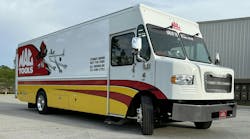Touchscreens. Bluetooth. Wireless. New technology can be alluring.
Sometimes it’s so easy to get swept up with what’s new and exciting that you forget the mainstay tools and equipment that technicians use every day. Those “boring” tool sales are often the ones you can bank on and that pay your mortgage.
Brake service tools can easily become one of those forgotten tool categories.
That’s not to say that there is nothing new in brake tools, there are some very interesting innovations. But the basic hydraulic braking system hasn’t changed much over the last few decades.
Brake job tool innovations just make a brake job faster and easier.
Q: What’s so special about brake tools?
A: There’s nothing magical about brake tools. But nearly every shop does brake jobs. That means nearly every shop has technicians that need bleeders, spreaders, spring compressors and other brake tools. But it’s easy to tote and promote what’s hot and cool and let these consistent moneymakers fall to the bottom of your list.
I can’t think of a shop in my neighborhood that doesn’t do brake jobs, whether the shingle out front says “mufflers,” “tires” or “general repair.”
“It’s probably one of the top three service areas a shop performs,” says Rob Kochie, specialty tools product manager at OTC Tools (otctools.com).
When you consider the other top service areas are oil changes, tires and batteries, brakes are one of the more tool intensive services.
“Working on brakes is a significant revenue stream for every shop,” says Ken Kresyman, Jr., Global Portfolio Manager, Automotive Aftermarket with MityVac (mityvac.com). “It’s a money maker … and it’s a great service … if you want to talk about vehicle safety.”
Q: Is there anything really new in brake tools?
A: Customers are always looking for new ways to solve old problems.
“We had an inventor that’s a tech call in with a better way to do something,” says Ross Tichy, VP of sales and marketing at Thexton Manufacturing (thexton.com). The inventor had found a way to save 15 to 20 minutes working on a GM “W” spring. “I think having the right tools to speed things up makes all the difference.”
If a tool helps your customer beat book rate and make money, he’ll buy it.
Speaking of innovation, automakers are investing a lot in collision avoidance systems, stability control, autonomous braking and automatic emergency braking. That means there is a lot of new technology on its way to your local independent shop.
“Twenty of the top automakers, which is almost all of them, agreed to equip almost every American car with Automatic Emergency Braking,” says Jeremiah Terry, general manager of Phoenix Systems (brakebleeder.com). This means AEB will be standard on most vehicles over the next few years.
Effective in 2013, all cars sold in the U.S. require Electronic Stability Control (ESC). Mandating ESC is estimated to have saved between 5,300 to 9,600 lives a year, Terry says. And most ESC technology depends on the braking system to function.
These and other new technologies will likely require and inspire many new tools.
Q: Isn’t toting and promoting a brake tool a waste of time?
A: It depends on the price, but focusing on one tool probably isn’t a good idea. However, a better approach is to consider “bundling” brake tools by service events, says Kochie.
Here’s an example of four major services and how you might showcase tools together:
- Line repair/replacement -- Put tube cutters and flare tools together
- Caliper/drum removal -- Bundle spreaders and spring tools for drums and discs
- Brake bleeding -- Show kits and various accessories
- Fluid service -- Promote moisture testers and test strips with fluid exchanger
Q: How can I demo brake tools when I tote and promote?
A: You can point out certain features by handing the customer the tool. They can usually see how an item can solve a problem. That’s why it’s important to not just promote common brake tools, but to actually stock them so you can show a customer the tool. And when a customer wants a brake tool, he or she usually wants it now.
But you make a good point; the benefits of some tools aren’t obvious and may be best shown with an on-car demo. That can be awkward and time-consuming to actually do in the bay.
So, for example, MityVac does this with videos on its parent company’s YouTube channel (youtube.com/lincolnindustrial). Most tool companies have demo videos on YouTube, Vimeo or their own websites.
Some shops use their truck video monitor to play these videos for clients while they are enjoying their Monster energy drink, Kresyman says.
Q: I was never a technician. What should I know about brake bleeders?
A: Air creates a spongy feeling and reduces braking effectiveness. That’s why technicians bleed brakes if they’ve had to open the system. Bleeding simply removes air bubbles in the brake line.
I haven’t bled brakes since I was a teen. Back then, I used primitive tools: a hose with a one-way valve and an empty bottle. Not the most efficient method, but cheap.
Today, professional technicians use professional brake bleeders that push or pull the fluid through the system. Kresyman points to three types of bleeder technology:
- Vacuum bleeder -- Pulls from the bleeder valve and draws the fluid out
- Pressure bleeder -- Pushes the fluid from the master cylinder out
- Reverse bleeder -- Pushes the fluid up from the bleeder valve
Each serves the purpose of getting air out of the hydraulic lines. These tools are also very useful for bleeding clutches. So, even when calling on a heavy duty fleet shop when their vehicles have air brakes, the bleeder can be useful on clutches.
Some brake bleeders are priced as a technician purchase. More advanced equipment, like brake fluid flush systems, tend to be a shop purchase. Know your customer and you’ll know which equipment will fit their needs.
Q: Anything else I should I know about brake fluid?
Brake fluid eats paint. I learned that as a teen, too -- the hard way. But more importantly, water in a brake line is not a good thing.
“Moisture is evil,” OTC’s Kochie says. Brake fluid is hygroscopic; it attracts water. Moisture in the brake system corrodes internal components, rusting brake lines and the pistons in your brake caliper. That can cause brakes to stick -- or worst case -- to fail.
A simple $30 brake fluid tester can digitally tell technicians the moisture level in the brake fluid so they know if a fluid exchange is needed and can show the customer. (Note: DOT 3 and DOT 4 fluid testers are different. So, most technicians should have one of each.)
Meanwhile, Phoenix Systems makes special rust test strips, Terry says.
For about $70 per 100 test strips, a shop can test vehicles for rust in the fluid. If you just explain how the test strips work, your customer will sell more fluid exchange services, drivers will be safer and you’ll get orders every month or two. It’s win-win-win. (Your one-sentence sales pitch is: “A 70-cent test strip can sell a $100 fluid exchange and keep your customers safer.)
Q: Any more advice on selling brake tools and equipment?
A: I can’t think of a downside of meeting customer demand.
“A good hand tool could last a customer’s entire career,” Thexton’s Tichy says.
I guess you could say that means you only get to sell it once. But I really don’t consider satisfied customers a downside. They’ll always want more tools.
“If you seek to sell value, and the value is aligned with what the customer values, then you are going to sell the tools or equipment,” MityVac’s Kresyman says.


